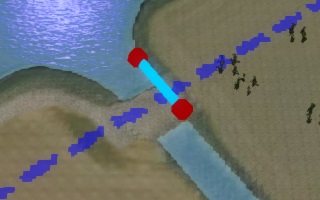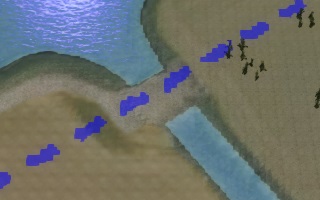How to correct a culvert connecting two water level areas: Difference between revisions
mNo edit summary |
No edit summary |
||
| Line 1: | Line 1: | ||
[[File:water-overlay-correction-waterareaconnected.jpg|300px|thumb|right|A culvert crossing the dotted blue line indicating the edge of a water | [[File:water-overlay-correction-waterareaconnected.jpg|300px|thumb|right|A culvert crossing the dotted blue line indicating the edge of a water area.]] | ||
[[File:water-overlay-correction-waterareaconnected-corrected.jpg|300px|thumb|right|With the Culvert removed no water flows across the edge.]] | [[File:water-overlay-correction-waterareaconnected-corrected.jpg|300px|thumb|right|With the Culvert removed no water flows across the edge.]] | ||
When using the Water Overlay, [[water | When using the Water Overlay, [[water area (Water Overlay)|Water Area]]s define how water is initialized at the start of the simulation. However, after initializing, the water is free to flow across the borders between separate Water Areas if this is physically possible. In most situations, Water Areas with waterways crossing their borders have a barrier, such as a [[Weir (Water Overlay)|Weir]] or a [[Pump (Water Overlay)|Pump]], which creates the physical barrier keeping the water levels at either side at the defined level. Although physically a [[Culvert (Water Overlay)|Culvert]] may exist between two Water Areas with different water levels, this would allow water to flow directly from the area with the higher water level to the area with the lower water level, without neccesarily ensuring the water level at either end is maintained. The {{software}} detects these situations and will show a warning for it, as a prompt to check explicitly whether this data is correct. | ||
* If the Culvert truely exists in that location, you don't need to do anything. The Culvert will function as expected, despite the warning. | * If the Culvert truely exists in that location, you don't need to do anything. The Culvert will function as expected, despite the warning. | ||
Revision as of 07:31, 28 May 2021
When using the Water Overlay, Water Areas define how water is initialized at the start of the simulation. However, after initializing, the water is free to flow across the borders between separate Water Areas if this is physically possible. In most situations, Water Areas with waterways crossing their borders have a barrier, such as a Weir or a Pump, which creates the physical barrier keeping the water levels at either side at the defined level. Although physically a Culvert may exist between two Water Areas with different water levels, this would allow water to flow directly from the area with the higher water level to the area with the lower water level, without neccesarily ensuring the water level at either end is maintained. The Tygron Platform detects these situations and will show a warning for it, as a prompt to check explicitly whether this data is correct.
- If the Culvert truely exists in that location, you don't need to do anything. The Culvert will function as expected, despite the warning.
- If the Culvert does not exist in that location, it is recommended to remove it.
- Select the Construction in the Editor.
- At the bottom of the left panel, select "Remove".
- Confirm that you want to want to remove the Culvert.

